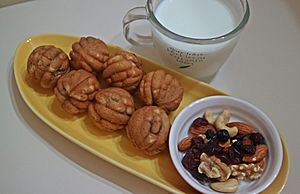Hodu-gwaja facts for kids
 |
|
| Alternative names | Hodo-gwaja, walnut cookies, walnut cakes, walnut pastries |
|---|---|
| Type | Cookie |
| Place of origin | South Korea |
| Region or state | Cheonan |
| Created by | Jo Gwigeum, Sim Boksun |
| Invented | 1934 |
| Main ingredients | Walnuts, red bean paste |
| Ingredients generally used | Wheat flour, eggs, milk, sugar |
| Korean name | |
| Hangul | |
|---|---|
| Hanja | |
| Revised Romanization | hodu-gwaja |
| McCune–Reischauer | hodu-gwaja |
| IPA | [ho.du.ɡwa.dʑa] |
Hodu-gwaja (pronounced "ho-doo-gwah-jah") is a yummy cookie from South Korea. People often call them walnut cookies, walnut cakes, or walnut pastries. They first came from a city called Cheonan.
These cookies look like small walnuts. They are baked and have a sweet red bean paste inside. The outside dough is made from crushed walnuts and wheat flour. If you find Hodu-gwaja made in Cheonan, they are a special treat from that area! Sometimes, you might also hear them called hodo-gwaja. This is another name used by the company that first made them.
History of Hodu-gwaja
Hodu-gwaja was first created in 1934. A married couple named Jo Gwigeum and Sim Boksun made them. They lived in Cheonan, South Korea.
They created the recipe based on old traditional Korean sweets. In the 1970s, Hodu-gwaja became very popular. You could often buy them at train stations. People also sold them from trolleys inside trains.
Today, you can find Hodu-gwaja in most parts of South Korea. This includes big cities like Seoul. You can even find them in other countries. For example, they are sold in cities like Los Angeles and San Diego in the United States.
Gallery
See also
 In Spanish: Hodu-gwaja para niños
In Spanish: Hodu-gwaja para niños



